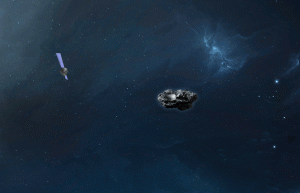
OMOTENASHI & EQUULEUS: the tiny spacecraft onboard the world’s most powerful rocket
Excitement is mounting for the inaugural launch of NASA’s Space Launch System (SLS): the first version of what will become the most powerful rocket ever developed that is destined to put humans back on the Moon by the mid-2020s. But onboard this 98m tall colossus are two particularly tiny robotic passengers.
OMOTENASHI and EQUULEUS are a type of ultra-small spacecraft referred to as CubeSats. The pair will piggy-back on the first SLS launch scheduled for the end of this month, alongside the launch’s main payload of a test flight for an uncrewed Orion module. Both developed at ISAS, the CubeSats are designed to test technology that will help future human exploration.
The “Outstanding Moon exploration TEchnologies demonstrated by NAno Semi-Hard Impactor” is more easily referred to as OMOTENASHI, meaning “hospitality” in Japanese. The 12.6kg spacecraft will be the world’s smallest lunar lander, demonstrating a semi-hard landing on the lunar surface without the large propulsion system utilised by large spacecraft.
Named for the stellar constellation, EQUULEUS stands for the “EQUilibriUm Lunar-Earth point 6U Spacecraft”. Weighing in at just 10.5kg, EQUULEUS will be the world’s first compact deep space explorer to test orbit control technology in the complex gravitational arena around the Earth and Moon. EQUULEUS will head to an orbit around the L2 Lagrange point, which is situated past the far side of the Moon.
The development of OMOTENASHI and EQUULEUS builds on previous Japanese CubeSats and nano-satellites, a journey that began in 2003 with the launch of two of the first CubeSats, XI-IV and CUTE-I. But compared to the most powerful rocket to be launched to date, what are the advantages of such tiny spacecraft?
“The small size and simplicity of the system allows CubeSats to be developed and launched in a short period of time and at low cost,” explains Professor Funase Ryu, who is leading the development of EQUULEUS. “This allows a variety of missions with high frequency.”
Professor Hashimoto Tatsuaki who leads the OMOTENASHI team adds that the low cost of CubeSats opens the door to new ideas that can then be applied to future missions.
“We can try challenging ideas or state-of-the-art technologies in CubeSats,” Hashimoto notes. “Not only for the instruments developed for the CubeSats, but also in the design concepts and operational plans that can be useful for larger missions.”

In order to take advantage of the low cost and short development time of CubeSats, it is essential to utilise commercially available parts. With the growing interest in CubeSats, smaller and less expensive ready-made components are becoming more readily available.
For example, the OMOTENASHI team tracked down a tiny attitude control device whose size was just 5cm x 10cm x 10cm and weighed less than 1 kg, but still managed to contain four Sun sensors, a 3-axis gyroscope and a star tracker for sensing the spacecraft’s orientation, and three reaction wheels for making adjustments to that posture.
The miniature lunar lander also carries a radiation detector that was originally not designed for space at all. The instrument is based on a portable dosimeter developed for school children after the accident at the Fukushima Daiichi Nuclear Power Station in the wake of the 2011 Tohoku earthquake. Onboard OMOTENASHI, it will test the use of such tiny dosimeters in space, and provide information on the radiation beyond Earth’s magnetic field that is needed to protect future crewed missions.
“If it works well, every exploration spacecraft could be recommended to carry this tiny dosimeter,” says Hashimoto. “And many observations will create a wealth of knowledge.”
However, few CubeSat missions are destined for deep space, and so many components still needed to the developed specifically for the OMOTENASHI and EQUULEUS missions. These were complex feats in engineering, due to the immensely compact size of the tiny crafts. Both OMOTENASHI and EQUULEUS are 6U CubeSats, which have a size of approximately 10cm x 20cm x 30cm. While bigger spacecraft typically fight weight constraints, it is this small volume that challenges CubeSat development.
“The density of usual spacecraft is not very high,” Hashimoto describes. “So the location of the instruments is not a very serious problem, and the focus is on controlling the total weight. But in the case of CubeSats, size and shape are very important. There is no space for connectors or screws. Therefore cables must be directly soldered, and some instruments are attached with adhesives. This means that once the CubeSat is built, we can no longer remove an instrument.”

Onboard EQUULEUS are three scientific instruments that were developed for the CubeSat. The first of these is DELPHINUS (DEtection camera for Lunar impact PHenomena IN 6U Spacecraft), which takes its acronym from the stellar constellation that sits alongside EQUULEUS in the summer sky. The instrument’s duel camera system aims to spot the flash from a colliding meteorite on the Moon’s far side for the first time.
The lack of atmosphere on the Moon means that incoming meteorites strike the lunar surface and generate a flash of light. Measuring both the frequency and effect of these impacts will help with risk assessment for crewed lunar activities.
“Lunar impact flashes can sometimes be observed from the Earth,” explains Funase. “However, the Earth has clouds which obscure the view and even without clouds, the Moon cannot be observed in the daytime. By actually staying in the vicinity of the Moon in space, EQUULEUS can observe the Moon’s surface for long periods of time, and allow us to discuss the statistical frequency of lunar flashes.”
The other two scientific instruments onboard EQUULEUS are PHOENIX (Plasmaspheric Helium ion Observation by Enhanced New Imager in eXtreme-ultraviolet) and CLOTH (Cis-Lunar Object detector within THermal insulation). PHOENIX will take advantage of the excellent view EQUULEUS will have of the Earth from space to explore the escape of our atmosphere by detecting the movement of helium ions that are visible in the ultraviolet. CLOTH is a detector for dust, with an ingenious design that uses a smart insulation material to detect dust collisions over two of the outer walls of the spacecraft, avoiding the need of a large separate sensor.

With a Moon landing as the goal, OMOTENASHI carries the dosimeter as the probe’s single scientific payload. The CubeSat comprises of an orbiting module to guide the tiny craft into a lunar impact orbit, a surface probe that will land on the Moon’s surface, and a solid rocket motor to decelerate the lander to make a semi-hard landing with a speed less than 50 m/s. To avoid the need for the weighty landing gear needed by over 110 previous landers on the Moon and Mars, OMOTENASHI is outfitted with a metal shock absorber that was manufactured using a 3D printer. While the minute lunar lander will not perform any scientific observations on the Moon, both the lander and the orbiting module are equipped with a UHF (430 MHz) radio transmitter that can be detected by radio enthusiasts around the world to follow the progress of the mission.
OMOTENASHI and EQUULEUS are pushing the boundaries of the capabilities of small spacecraft in deep space. One future mission that will leverage their capabilities is the ESA-led Comet Interceptor, which consists of a mothership and two smaller probes, one of which will be provided by JAXA. The mission aims to chase after a rare long period comet or interstellar object which sweep rapidly through the inner Solar System, providing only a brief, single opportunity for observation. The use of agile small spacecraft will allow multiple perspectives for such a one-off opportunity.
With a plethora of moons, asteroids and comets yet unvisited, OMOTENASHI and EQUULEUS are proving that large does not always equate to power for unlocking the secrets of the Solar System.
(Thumbnail of the SLS on the ISAS home page: NASA / Joel Kowsky)
Further Information:





 Previous Post
Previous Post Next Post
Next Post






